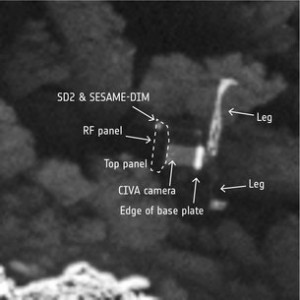Philae found, Credit: ESA / Rosetta / MPS for OSIRIS Team MPS / UPD / LAM / IAA / SSO / INTA / UPM / DASP / IDA
The high-resolution camera Rosetta has revealed images captured on September 2, showing the Philae lander that is embedded in a dark rift in the 67P / Churyumov-Gerasimenko, according to information from the European Space Agency (ESA).
the last once Philae was seen, it was after landing first in Agilkia on 12 November 2014. the lander bounced and flew for two hours before ending up in a smaller place later called Abydos, in the lobe comet, ESA says.
less than one month before the end of the mission, the images clearly show the main body of the lander, along with his three legs. In addition, they provide an orientation test Philae clarifying the reason for the difficult establishment after landing.

Close up of Philae. Picture shows evidence of dePhilae orientation. two of the three legs of the lander are seen at a resolution of 5 cm / pixel. Credits: ESA / Rosetta / MPS for OSIRIS Team
According to reports ESA, after three days, the primary battery of Philae ran out and the lander went into hibernation, could communicate briefly with Rosetta in June and July 2015 when the comet moved closer to the Sun and had more power available. However, until now was unknown its precise location.
“This remarkable discovery occurs at the end of a long and painful search,” says Patrick Martin, director of the Rosetta mission of ESA, according to the website of the agency. “We were beginning to think Philae would be lost forever. It’s amazing that we have caught at the last moment “ div id => “.” //www.lagranepoca. com / wp-content / uploads / 2016/09 / ESA_Rosetta_OSIRIS_NAC_2016-09-02T19.57.34.628Z_ID10_1397549000_F22_enhanced2-350×350-300×300.png “alt =” Im & # XE1; gene taken from OSIRIS on September 2, 2016 at 27 km from Philae . Cr & # XE9; Credit: ESA / Rosetta / MPS for OSIRIS Team MPS / UPD / LAM / IAA / SSO / INTA / UPM / DASP / IDA “width =” 300 “height =” 300 “class =” size-medium wp -image-84923 “/> OSIRIS image taken from the September 2, 2016 at 27 km from Philae. Credit: ESA / Rosetta / MPS for OSIRIS Team MPS / UPD / LAM / IAA / SSO / INTA / UPM / DASP / IDA
No comments:
Post a Comment